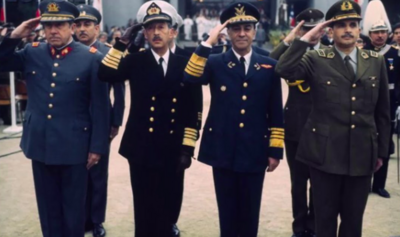2003 Creeperian coup attempt
| 2003 Creeperian coup d'état | |||||||||
|---|---|---|---|---|---|---|---|---|---|
| Part of the Creeperian Conflicts | |||||||||
 The military leaders of the coup. | |||||||||
| |||||||||
| Belligerents | |||||||||
|
|
Supported by: | ||||||||
| Commanders and leaders | |||||||||
|
|
| ||||||||
| Units involved | |||||||||
| Strength | |||||||||
| 650 soldiers | 102,180 soldiers | ||||||||
| Casualties and losses | |||||||||
|
459 dead 66 executed 125 imprisoned | 138 dead | ||||||||
| 597 military dead, 44 civilians dead, thousands missing | |||||||||
The 2003 Creeperian coup d'état (Creeperian Spanish: Golpe de Estado Creeperiano de 2003), also sometimes referred to as The Coup (Creeperian Spanish: El Golpe), The Restoration (Creeperian Spanish: La'Restoración), or 18-J, was a military coup d'état in Creeperopolis that deposed the totalitarian government. On 18 June 2003, after four years of totalitarian rule, overt government corruption, political unrest, severe hyperinflation, and surging crime rates, the Creeperian Armed Forces, lead by Chief Field Marshal Augusto Cabañeras Gutiérrez, Chief Admiral Edmundo González Robles, and Chief General Arturo Merino Núñez, seized power in a coup d'état. and established a short-lived transitionary military junta.
During the coup, the army, navy, and air force attacked the Council of Mayors building in San Salvador during a meeting of Alfonso VI with his government ministers and high ranking loyalist mayors. Many were killed or later executed. The San Salvador Imperial Palace and other important government buildings were secured by the armed forces with little to no resistance from imperial guardsmen. The military declared martial law in the wake of the coup and a 10pm curfew was initiated across the country.
The armed forces established a military junta and initiated large-scale purges of political and military officials. Cabañeras Gutiérrez gained significant power following the coup and is considered to be one of the most powerful people in Creeperopolis. The military proclaimed Alfonso VI's second and oldest surviving son, Alexander II, as the new Emperor, but the military held absolute authority and control until he was coronated on 15 September 2003 and the junta was officially dissolved. The military, however, continues to hold significant power and influence in Creeperian politics and national governance.
The coup marked a watershed moment in Creeperian history and began the true modernization of the nation and the resurgence of its economy. The coup has been proclaimed by Creeperian propaganda as an event which saved the nation from its impending demise.
Contents
Background
Political situation
Following the conclusion of the Creeperian Civil War in 1949, the victorious Catholic Imperial Restoration Council under Emperor Romero II established the Council of Mayors, the legislative body of the country that replaced the Parliament. The Imperial Council also established the Creeperian National Military Tribunal, the judiciary body of the country that replaced the High Court. Executive power in the country shifted from the abolished office of Prime Minister to the imperial throne, while office of Prime Minister was transitioned to the office of Chief Mayor. The nine ministries of the country remained in place, and most were dominated by the military until they were gradually given over to Initiative administration.
The Nationalist Creeperian Catholic Royal Initiative and the Pro-Fatherland Front of Unification, commonly known as the Creeperian Initiative or simply the Initiative, was established as the sole legal political party as a merger of right-wing political parties in Creeperopolis and its newly annexed territories of Atlántida and Castilliano. The Initiative held all 6,123 seats on the Council of Mayors, and it functioned effectively as a body that merely approved the actions of the Emperor, almost always voting unanimously in favor of bills.
Military situation
Economic recession
Planning the coup
Casualties
Alfonso VI's death
Aftermath
Military rule and transition
Following the coup d'état, the military established the the Romerist Military Junta, a military junta that weilded absolute power and authority in Creeperopolis. The military junta composed of Cabañeras Gutiérrez, González Robles, Merino Núñez, Barrios Dueñas, with Cabañeras Gutiérrez serving as the President of the junta.
[Cabañeras Gutiérrez (Army):] The Armed Forces have acted today solely under patriotic and nationalist inspiration of saving the Fatherland from the tremendous chaos and anarchy into which He was being plunged into by the Miguelist regime of Alfonso VI.[b] The Romerist Military Junta will maintain executive, legislative, and judicial authority while it is in power. The Council of Mayors will remain in recess until further notice, and we officially proclaim Alexander Romero Adolfo Martínez Hernández as Emperor, to be coronated on 15 September 2003 in accordance with the Fatherland's tradition, when this junta will dissolve and hand over power to the rightful Emperor and Council and Tribune.
[González Robles (Navy):] It is unfortunate that we have had to break the imperial and God-sanctioned tradition of succession and governance which in the Fatherland has lasted since the establishment of the Fatherland by Felipe I, however, when the Fatherland loses His qualities and His foothold, there are those, who by mandate, have to enforce them and support Him and take on that task. The Armed Forces have done that today, and with God's divine approval, we are sure that all of Creeperopolis has to understand the sacrifice that entails.
[Merino Núñez (Air Force):] This is not a matter of squashing tendencies, or ideological trends, or carrying out personal revenge, but, as the Romerist Military Junta has stated, of re-establishing public order and returning the Fatherland to observance of not only the national Constitution and laws, but also of the divine laws of God presented through the Prophets and through the Savior, Jesús Cristo.
[Barrios Dueñas (Imperial Guard]:] After four years of suffering the Miguelist cancer which led us to economic, moral, and social disaster which can no longer be tolerated for the sacred interests of the Fatherland, we find ourselves obliged to take on the difficult and painful mission which the Armed Forces have undertaken. We are not afraid; we know the enormous responsibility that will rest on our shoulders, but we are convinced, and we are quite sure that the vast majority of the Creeperian people are with us. They are willing to fight against Miguelism! They are willing to stand with God and stamp it out down to the final consequences!
— Romerist Military Junta, 18 June 2003
The military established martial law and a 10pm curfew across the entire country.
Political ramifications
Purges
Reactions
Domestic reactions
International reactions
Legacy
In popular culture
Commemoration
See also
Notes
- ↑ Alexander II had little involvement in the actual planning or execution of the coup d'état, but he was used as a figurehead of the Romerist Military Junta following the coup d'état and was declared as a vital asset in the success of the coup d'état.
- ↑ Augusto Cabañeras Gutiérrez called the regime of Alfonso VI as "Miguelist," a far-left ideology that is a form of communism formed by the National Council for Peace and Order during the Creeperian Civil War of 1933 to 1949. The ideology was formed by individuals such as Miguel VII, Cayetano Handel Carpio, Joel Lacasa Campos, and Mariano Alcocer Fraga. The government of Alfonso VI was by no means in any form Miguelist except for the fact that it was very totalitarian. The government of Alfonso VI fits more with the Romerist ideology the military junta claimed to abide by, but much more totalitarian. He likely used the term Miguelist in order to demonize his government, damage his government's credibility, and eliminate any remaining support for Alfonso VI.
References
Bibliography
- Pareja Palau, Orlando (2009). Guerra Civil [Civil War]. Historia de Creeperopólis (in Creeperian Spanish). 3 (2 ed.). San Salvador, Creeperopolis: Impresión Creeperiano. pp. 666–693. doi:10.1017/S0022216X00001425. ISBN 9780742537415. JSTOR 156558.CS1 maint: unrecognized language (link)
- Pareja Palau, Orlando (2013). El Autogolpe de 2003 [Coup d'État of 2003]. Historia de Creeperopólis (in Creeperian Spanish). 2 (2 ed.). San Salvador, Creeperopolis: Impresión Creeperiano. pp. 1–554. doi:10.4067/S0718-04622015000200006. ISBN 978-1-56584-936-5. JSTOR 4491811.CS1 maint: unrecognized language (link)







